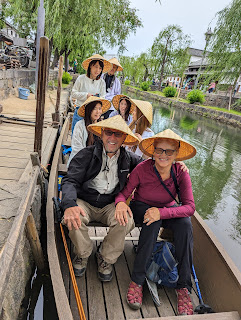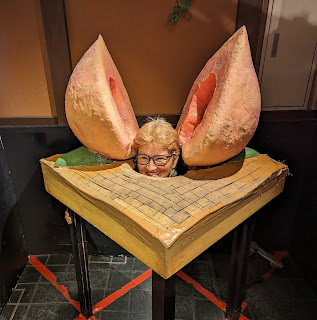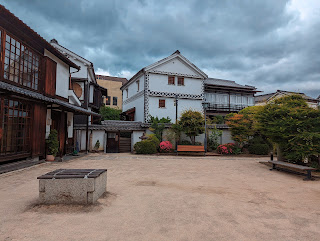The Western-style building on the right below, constructed in 1917 at the height of Kurashiki's spinning industry as the Town Hall, has been converted into the Tourist Information Office and as a symbol of the Bikan. Like so many places we'd come across in Japan, it had several vending machines. After queuing in line for close to an hour, I was ecstatic when I managed to purchase two tickets for a punt boat ride on the canal later.
If you were hankering after something in any color other than blue while shopping in Kurashiki, you'd have had a tough time as denim blue was about the only choice!
I stopped at the Tanex612 Factory to look at the hundreds of rolls of washi or masking tape that's used for scrapbooking and arts and crafts. Although we'd seen washi elsewhere in Japan, it was special to look at all the fun designs in Kurashiki, as it was the birthplace of washi tape.
If you couldn't find a pattern you liked there, believe me, you couldn't find it anywhere!
After sleeping in, Steven joined me where, away from the canal in old town Kurashiki, we happened to come across a less touristed area though it was still part of Bikan, and took a wander.
The Inoue House, the oldest building in the Bikan area, was built during the Edo Period approximately 300 years ago for an influential family that led the town administration.
The former Chugoku Bank had been converted into a community center.
At the bottom of Tsuragatayama Hill was Kanryu-ji Temple with nary a soul anywhere. Its majestic trees were what appealed to me.
We took a deep breath before climbing to what we thought and hoped would be Achi Shrine but we ended up taking a very roundabout detour.
Yeah - more steps!
From atop Tsuragatayama Hill, we enjoyed a panoramic and unobstructed view of Kurashiki. The Achi Shrine has been around for more than 1,700 years. When the hill was much closer to the Seto Inland Sea hundreds of years ago, it made Achi Shrine the perfect spot for enshrining the goddesses of the sea and voyages.
After a long hike around the newer part of Kurashiki, we ascended the final steps to Achi Shrine and hoped it would be the last climb of the day. Unfortunately, once again there were no signs to indicate what building was which at the large shrine complex.
A children's art display:
The primary reason Steven and I had come to Achi was because it is known for the massive sacred granite rocks called iwakura that had origins in Korean shamanistic roots. We had a devil of a time finding the rocks on the temple grounds as we didn't know what we were looking for and there were no signs once again for any of the buildings or significant sights. I had to ask people at one of the temple buildings twice where the rocks were as there was no way we were going to miss seeing them after climbing up what seemed like 1,001 steps!
The long walk down to the historical area:
Many religious sights dispensed, for a fee, tiny paper dolls with an inscription wrapped around each one.
When we'd been on the hill, Steven and I had heard continuous loud noises and music far below but we had no clue why. Back by the canal in the Bikan district, we came across a huge parade but had no idea of its origin or purpose. Was it religious and therefore honoring a special leader or god? Was it an agricultural parade appealing to the patrons of farmers? Was it simply a fun cultural activity to bring the community together? Your guess is as good as mine!
Whatever it was, our canal cruise wouldn't start for a bit so we followed the parade to see what it was all about. Click on the pictures to make them bigger so you can get a clear shot of the group of about six men and women on each side of the float balancing a long pole on their shoulders. Each side took turns swaying, switching the weight from one side to the other side of the float on commands of the leader. Most participants wore the same costume but I had no idea what it represented.
It must have been grueling because we noticed some participants bowing out and reinforcements quickly taking their places to hold up the float. It felt like all of Kurashiki was supporting the participants as the sizeable crowd chanted in tune with the participants.
Occasionally some balancing of the float by the rear guard was required to ensure it was still on an even keel on the narrow sidewalk!
Each side took turns chanting as if in response to each other or what may have been a sort of one-upmanship!
Even not knowing what the parade was about Steven and I were thrilled that we'd happened to be in Bikan when it took place as it was a highlight in a town full of highlights!
Our reserved boat ride was about to begin but I (and many other tourists!) were all agog watching this Japanese couple in traditional dress being escorted down the canal in their beautifully decorated boat. When they did what looked like the royal wave, mouths dropped and cameras whirred. Was this a famous couple in Japan, part of the imperial family? We had no clue but followed the boat for a bit as it turned down the canal and under the bridge.
Seeing the participants occasionally raise the float high in the air as they needed to clear certain buildings or as they turned onto the bridge made me hold my breath, hoping it wouldn't fall. But then I found myself gasping as we saw the float being raised and lowered repeatedly.
We smiled when we noticed the traffic cones by the tiny boat dock matched the traditional black-and-white architecture in the Bikan area.
Sure, this was a touristy thing to do in Kurashiki but we were tourists after all and a ride down the canal seemed like it would be a hoot. We were given a sugegasa or traditional conical Japanese straw to wear which even Steven gamely donned!
We were in luck as we passed the 'royal couple' and were treated to our own royal wave.
Not sure what these mask-wearing characters were all about on the shore!
Just as we'd taken shots of other passengers on boats the day before, the tables were now turned and our mugs would be in lots of photo albums!
I loved taking shots from the water as they were different perspectives from what we'd viewed earlier. For example, we had a far less obstructed view of the Ohara Museum of Art from the water than we had the day before when the tree blocked much of the museum.
Our boatman or gondolier only spoke Japanese so we couldn't understand what he was saying when he was presumably mentioning the points of interest on the cruise. We seemed to spend an inordinate amount of time under one of the bridges as he chatted but, about what, we were none the wiser.
After the extremely enjoyable boat ride, it was back to Denim Street for a blue-colored ice cream cone. I don't know what I expected it to taste like but banana-flavored wouldn't have been it! Am I glad I tried it - yes, of course, but I was sure glad Steven was there to finish eating it as I'll stick to plain old vanilla or chocolate any day.
Since arriving in Kurashiki the previous morning, we'd passed this shop or museum or whatever it was several times without knowing what it was as the signage was almost nonexistent. I'd even taken a photo of the unusual character out front. We only 'discovered' what it was when we looked again at the itinerary we'd written up months ago and realized this was the Momotaro Karakuri Museum that we'd been looking for.
According to one of Japan’s best-known folk tales, Momotaro is a legendary character who was born from a giant peach or momo and made friends with a dog and a monkey by offering them kibi-dango or sticky dumplings. Together they grew up to defeat ogres and save his village.
No wonder there was no advertising out front as the very small building could only handle a few visitors at a time. Plus, add in that each small group was taken around by an employee to the extraordinarily fun exhibits and we could see why numbers had to be limited.
No wonder there was no advertising out front as the very small building could only handle a few visitors at a time. Plus, add in that each small group was taken around by an employee to the extraordinarily fun exhibits and we could see why numbers had to be limited.
The guide told us to look at the momo from two different mirrored angles so Peach Boy could pop out!
This character looked like Mr. Potato Head of yore.
Another mirror trick that made us laugh involved holding one leg up by special mirrors so that it appeared we were suspended! Our guide managed it perfectly, Steven not so much but he had a blast trying!
Momotaro evidently spawned a whole industry of games, books, and toys just like his pal Mickey Mouse.
The Yurin-so Villa had been the former vacation home of the Ohara family who were critical in the city's history as a spinning capital and also founded the excellent Ohara Museum Of Art. It was also called Midori Goten or Green Villa because of its distinctive green roof.
We were pretty wiped by then so we only stopped for a few minutes at the Kurashiki Monogatarikan, a cultural and tourism facility on the outskirts of Bikan. Restored buildings gave visitors what life might have been like in 1760, the middle of the Edo Period.
Another night in Kurashiki meant for us finding another Italian restaurant! Not the norm, we know for most visitors, but we were happy. This one had won all sorts of awards and made us think we'd been plopped into the middle of a trattoria in Sicily several months earlier than planned.
When we got to the Magic Table, I poked my head through the hole in the table so my body 'disappeared.'
Another illusion involved our putting our hands inside a peach and shaking hands with the approaching fingers!
The Vortex Rotation trick was apparently invented 150 years ago. We pushed a button to spin the disc, then stared at it for twenty seconds until it stopped. Miraculously, the flowers opened up before our eyes!
This character looked like Mr. Potato Head of yore.
I read that the folk tale is often taught in schools and is a favorite among children in Japan. That was probably why the museum displayed so many prints and other exhibits related to Momotaro.
Of course, this being all about Peach Boy defeating the demons and ogres, there was a sneezing demon jumping out at us as we climbed to the second story!
Another mirror trick that made us laugh involved holding one leg up by special mirrors so that it appeared we were suspended! Our guide managed it perfectly, Steven not so much but he had a blast trying!
Phil: I remember thinking that if I have you pegged right, you'd have gotten a scream out of this place just like we did.
Some of the pictures of Momotaro on the upper level were over 200 years old!
Notice the war-themed image from 1943:
From 1890:
Momotaro evidently spawned a whole industry of games, books, and toys just like his pal Mickey Mouse.
Steven, never one to give up on a challenge, mastered the Flying Mirror trick before we left!
The Yurin-so Villa had been the former vacation home of the Ohara family who were critical in the city's history as a spinning capital and also founded the excellent Ohara Museum Of Art. It was also called Midori Goten or Green Villa because of its distinctive green roof.
We were pretty wiped by then so we only stopped for a few minutes at the Kurashiki Monogatarikan, a cultural and tourism facility on the outskirts of Bikan. Restored buildings gave visitors what life might have been like in 1760, the middle of the Edo Period.
Another night in Kurashiki meant for us finding another Italian restaurant! Not the norm, we know for most visitors, but we were happy. This one had won all sorts of awards and made us think we'd been plopped into the middle of a trattoria in Sicily several months earlier than planned.
Steven and I had so, so much fun in Kurashiki from the moment we arrived - the lovely shops on the pedestrian streets and narrow alleys, the town's interesting history of the spinning industry and its avante-garde labor practices, the picturesque canal running through the historical Bikan area, the lucky opportunity to take a punting boat ride, the lovely traditional homes, the scenic Ivy Square Hotel, the fun Denim Street and all things blue, and, of course, Momotaro made for an idyllic stay in Kurashiki.
Next post: From the sublime to the sobering with a visit to Hiroshima.
Posted on July 29th, 2024 from our home in sun-filled Colorado where we're due to have 90-plus degree temps all week long. Please make sure to take care of yourself and your loved ones.







































































































